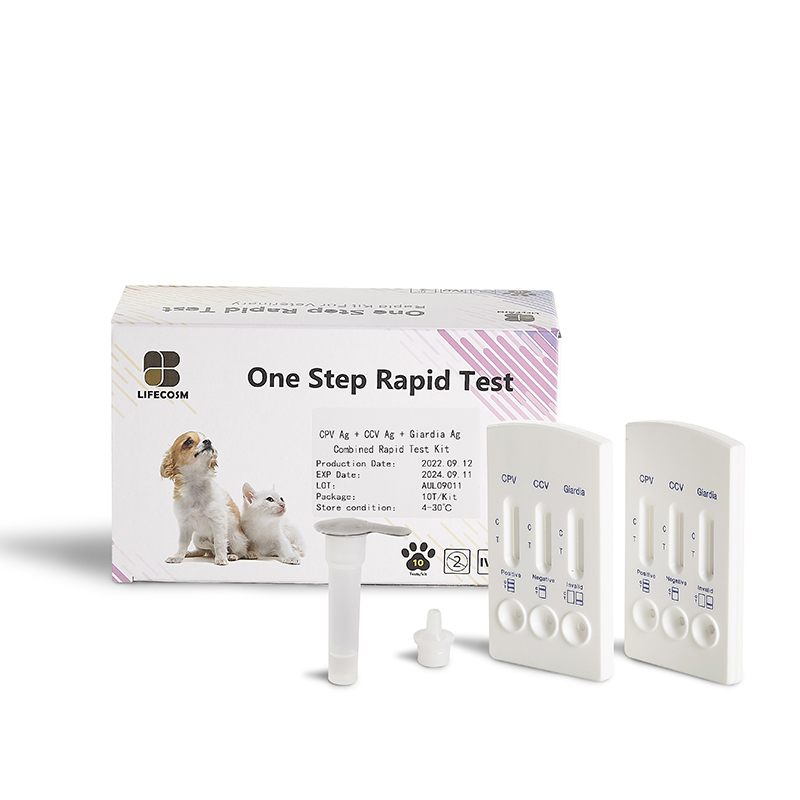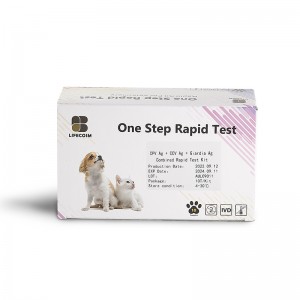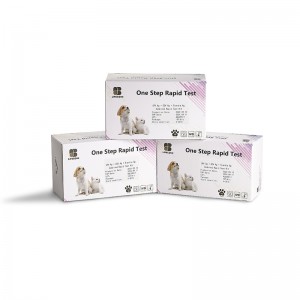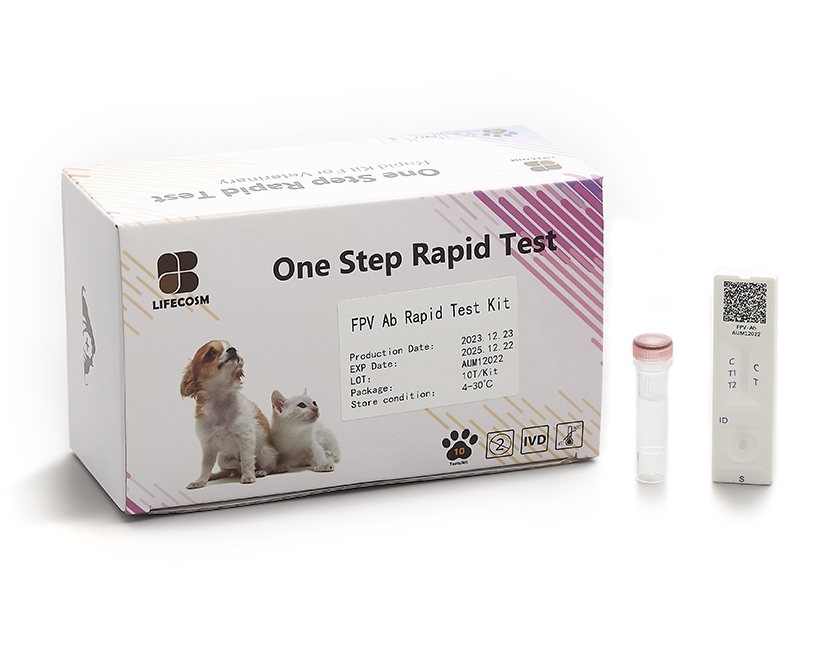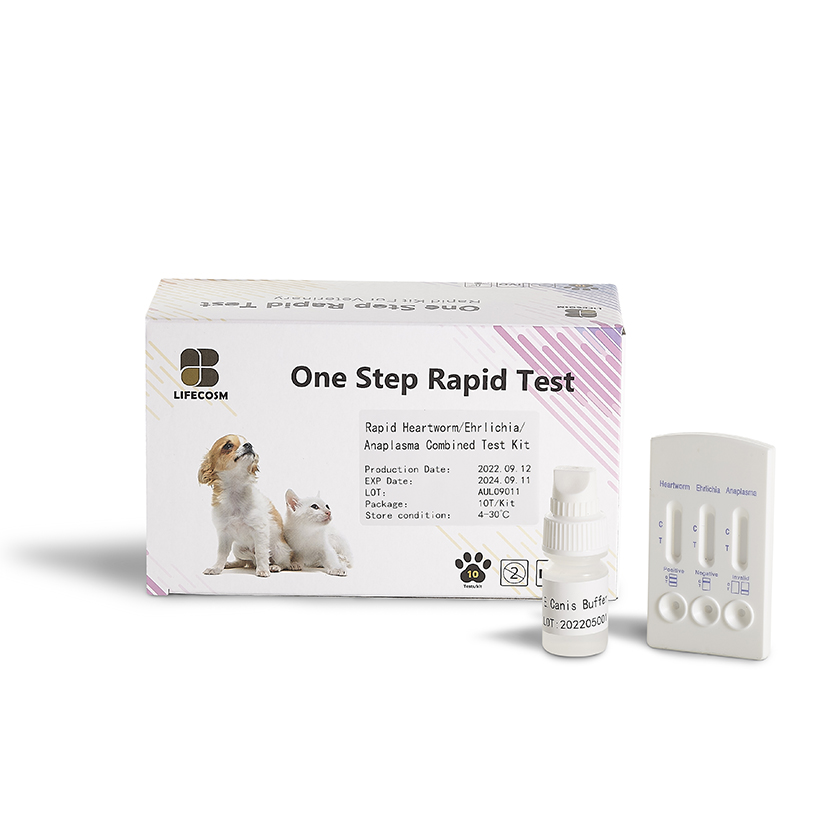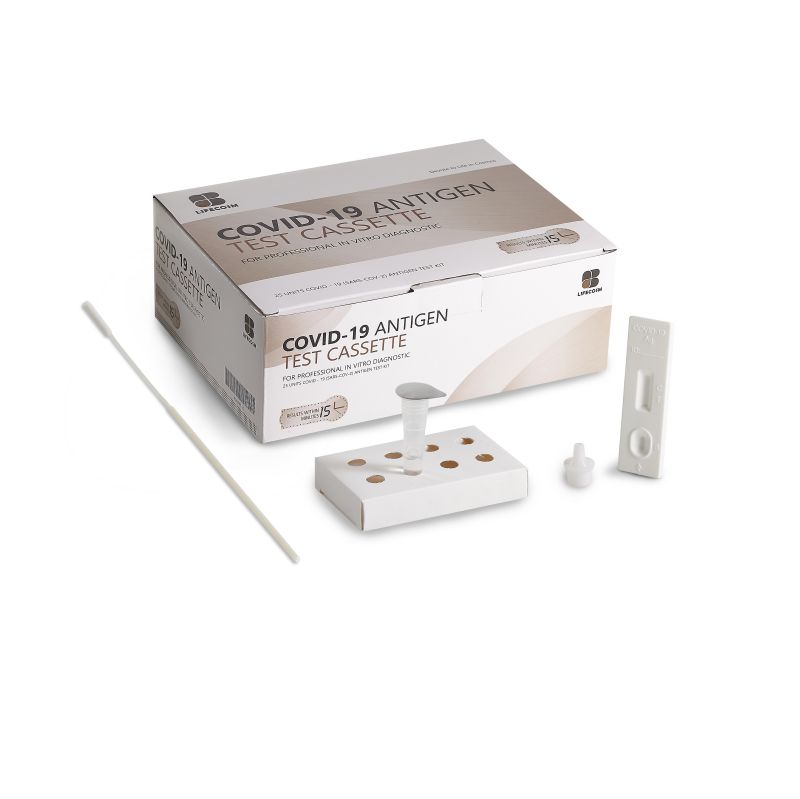
Products
Lifecosm Canine Coronavirus Ag/Canine Parvovirus Ag/Giardia Ag test kit
CCV/CPV/GIA Ag Test Kit Canine Coronavirus Ag/Canine Parvovirus Ag/Giardia Ag test kit
| Catalog number | RC-CF09 |
| Summary | Detection of specific antigens of CCV, CPV and GIA within 10 minutes |
| Principle | One-step immunochromatographic assay |
| Detection Targets | CCV antigens, CPV antigens and Giardia Lamblia |
| Sample | Canine Feces |
| Reading time | 10 minutes |
| Quantity | 1 box (kit) = 10 devices (Individual packing) |
| Contents | Test kit, Buffer bottle, Disposable droppers, and Cotton Swabs |
| Storage | Room Temperature (at 2 ~ 30℃) |
| Expiration | 24 months after manufacturing |
|
Caution |
Use within 10 minutes after openingUse appropriate amount of sample (0.1 ml of a dropper)
Use after 15~30 minutes at RT if they are stored under cold circumstances Consider the test results as invalid after 10 minutes |
Information
◆ CCV
Canine Coronavirus (CCV) is a virus that affects the intestinal tract of dogs. It causes a gastroenteritis similar to parvo. CCV is the second leading viral cause of diarrhea in puppies with canine Parvovirus (CPV) being the leader. Unlike CPV, CCV infections are not generally associated with high death rates. CCV is a highly contagious virus affecting not only puppies, but older dogs as well. CCV is not new to the canine population; it has been known to exist for decades. Most domestic dogs, especially adults, have measurable CCV antibody titers indicating that they were exposed to CCV at some time in their life. It is estimated that at least 50% of all virus-type diarrhea is infected with both CPV and CCV. It is estimated that over 90% of all dogs have had exposure to CCV at one time or another. Dogs that have recovered from CCV develop some immunity, but the duration of immunity is unknown.
CCV is a single stranded RNA type of virus with a fatty protective coating. Because the virus is covered in a fatty membrane, it is relatively easily inactivated with detergent and solvent-type disinfectants. It is spread by virus shedding in the feces of infected dogs. The most common route of infection is contact with fecal material containing the virus. Signs begin to show 1-5 days after exposure. The dog becomes a “carrier” for several weeks after recovery. The virus can live in the environment for several months. Clorox mixed at a rate of 4 ounces in a gallon of water will destroy the virus.
◆ CPV
In 1978 was known a virus which infected dogs regardless of age to damage enteric system, white cells, and cardiac muscles. Later, the virus was defined as canine parvovirus. Since then, the outbreak of the disease has been on the rise worldwide.
The disease is transmitted through direct contacts among dogs, in particular in places like dog training school, animal shelters, playground and park etc. Even though canine parvovirus does not infect other animals and human beings, dogs can be infected by them. Infection medium is usually the feces and urine of infected dogs.
Information
◆ GIA
Giardiasis is an intestinal infection caused by a parasitic protozoan (single celled organism) called Giardia lamblia. Both Giardia lamblia cysts and trophozoites can be found in the feces. Infection occurs by the ingestion of Giardia lamblia cysts in contaminated water, food, or by the fecal-oral route (hands or fomites). These protozoans are found in the intestines of many animals, including dogs and humans. This microscopic parasite clings to the surface of the intestine, or floats free in the mucous lining the intestine.
Symptoms
◆ CCV
The primary symptom associated with CCV is diarrhea. As with most infectious diseases, young puppies are more affected than adults. Unlike CPV, vomiting is not common. The diarrhea tends to be less profuse than that associated with CPV infections. The clinical signs of CCV vary from mild and undetectable to severe and fatal. Most common signs include: depression, fever, loss of appetite, vomiting, and diarrhea. The diarrhea can be watery, yellowish-orange in color, bloody, mucoid, and usually has an offensive odor. Sudden death and abortions sometimes occur. The duration of illness can be anywhere from 2-10 days. Although CCV is generally thought of as a milder cause of diarrhea than CPV, there is absolutely no way to differentiate the two without laboratory testing.
Both CPV and CCV cause the same appearing diarrhea with an identical odor. The diarrhea associated with CCV usually lasts several days with low mortality. To complicate the diagnosis, many puppies with a severe intestinal upset (enteritis) are affected by both CCV and CPV simultaneously. Mortality rates in puppies simultaneously infected may approach 90 percent.
◆ CPV
The first symptoms of the infection include depression, appetite loss, vomiting, severe diarrhea, and the increase in temperature of the rectum. The symptoms occur 5~7 days after infection.
The feces of the infected dogs become light or yellowish gray. In some cases, fluid-like feces with blood can be shown. Vomiting and diarrhea causes dehydration. Without treatment, dogs suffering from them can die of fit. Infected dogs usually die 48~72 hours after showing the symptoms. Or, they could recover from the disease without complications.
Symptoms
◆ GIA
The trophozoites divide to produce a large population, then they begin to interfere with the absorption of food. Clinical signs range from none in asymptomatic carriers, to mild recurring diarrhea consisting of soft, light- colored stools, to acute explosive diarrhea in severe cases. Other signs associated with giardiasis are weight loss, listlessness, fatigue, mucus in the stool, and anorexia. These signs are also associated with other diseases of the intestinal tract, and are not specific to giardiasis. These signs, together with the beginning of cyst shedding, begin about one week post-infection. There may be additional signs of large intestinal irritation, such as straining and even small amounts of blood in the feces. Usually the blood picture of affected animals is normal, though occasionally there is a slight increase in the number of white blood cells and mild anemia. Without treatment, the condition may continue, either chronically or intermittently, for weeks or months
Treatment
◆ CCV
There is no specific treatment for CCV. It is very important to keep the patient, especially puppies, from developing dehydration. Water must be force fed or specially prepared fluids can be administered under the skin (subcutaneously) and/or intravenously to prevent dehydration. Vaccines are available to protect puppies and adults of all ages against CCV. In areas where CCV is prevalent, dogs and puppies should remain current on CCV vaccinations beginning at or about six weeks of age. Sanitation with commercial disinfectants is highly effective and should be practiced in breeding, grooming, kennel housing, and hospital situations
◆ CPV
Until now, there are no specific medicines to eliminate all viruses in the infected dogs. Therefore, early treatment is critical in curing infected dogs. The minimization of electrolyte and water loss is helpful for preventing dehydration. Vomiting and diarrhea should be controlled and antibiotics should be injected into the sick dogs to avoid second infection. More importantly, a close attention should be paid to the sick dogs.
◆ GIA
Dogs have a high infection rate, as 30% of the population under one year old are known to be infected in kennels. Infected dogs can be isolated and treated, or the entire pack at a kennel can be treated together regardless. There are several options of treatment , some with two- or three-day protocols and others needing seven-to-10 days to complete the job. Metronidazole is an old stand-by treatment for bacterial infestations that cause diarrhea and is about 60-70 percent effective in curing giardiasis. However, Metronidazole has potentially serious side-effects in some animals, including vomiting, anorexia, liver toxicity, and some neurological signs, and it cannot be used in pregnant dogs. In a recent study, Fenbendazole, which is approved for use in treating dogs with roundworm, hookworm, and whipworm, has been shown to be effective in treating canine giardiasis. Panacur is safe to use in puppies at least six weeks of age.
Prevention
◆ CCV
Avoiding dog to dog contact or contact with objects that are contaminated with the virus prevents infection. Crowding, dirty facilities, grouping large numbers of dogs, and all types of stress make outbreaks of this disease more likely. Enteric coronavirus are moderately stabile in heat acids and disinfectants but not nearly so much as Parvovirus.
◆ CPV
Regardless of age, all dogs must be vaccinated against CPV. Continuous vaccination is necessary when the immunity of dogs is not known.
Cleaning and sterilization of kennel and its surroundings are very important in preventing the spread of viruses. Be careful that your dogs do not contact the feces of other dogs. In order to avoid the contamination, all feces must be managed properly. This effort should be done with all people participating to maintain the neighborhood clean. In addition, consultation by experts like veterinarians is essential in the prevention of the disease.
◆ GIA
In large kennels, mass treatment of all dogs is preferable, and the kennel and exercise areas should be thoroughly disinfected. Kennel runs should be steam-cleaned and left to dry for several days before dogs are reintroduced. Lysol, ammonia, and bleach are effective decontamination agents. Because Giardia crosses species and can infect people, sanitation is important when caring for dogs. Kennel workers and pet owners alike should be sure to wash hands after cleaning dog runs or removing feces from yards, and babies and toddlers should be kept away from dogs that have diarrhea. When traveling with Fido, owners should prevent him from drinking potentially infected water in streams, ponds, or swamps and, if possible, avoid public areas polluted with feces.

